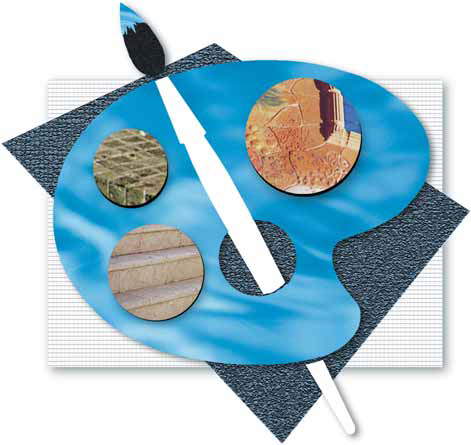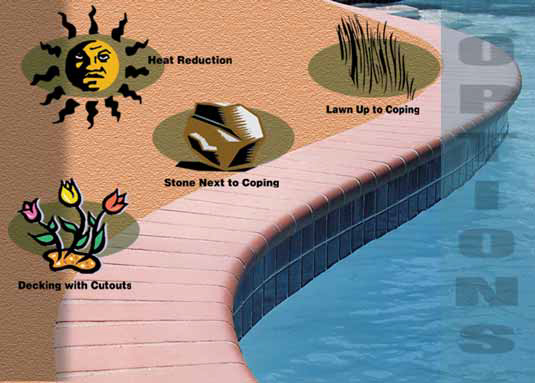construction
There's much to be said about this brave, new world of watershaping we're in right now - and one of the things that's most abundantly clear is that clients expect more these days: What was "good enough" before just won't cut it, and to my way of thinking, that's a very good thing! One of the areas that most reflects this increase in expectations is the selection of the materials we use. More and more people I talk to around the country are now using things they wouldn't even have considered just five years ago - things that can add tremendous
It's a basic and important idea: Quality and beauty can and should be provided across a wide range of pricing levels. In my work, I design and build many residential and commercial watershapes with budgets well into six figures; I also tackle many projects firmly planted in the five-figure range. No matter the budget, I believe strongly that I owe it to my clients to deliver a watershape of lasting beauty each and every time. Fact is, quality and artistry often can be achieved with a distinctly uncomplicated program. By bringing a watershape's design into harmony with the architecture of the home and/or other adjoining structures, it's often possible to enhance aesthetics and value without dramatically increasing the price tag. Take the project seen here as an example: Through careful placement and shaping of the vessel, artistic edge treatments and minor elevation changes - none of which added appreciably to the cost - I left my clients with a watershape they love at a price they could
It used to be that competition pools were the sole province of big engineering/construction companies with their substantial assets, impressive inventories of equipment, huge labor forces and established skills in working with low-tolerance plans and specifications. The arrival on the scene of modular stainless steel pool systems has changed all that - and it's a good thing, because so many competition and training pools are being built today that there are not enough qualified construction companies of the traditional sort to get around to installing them all. This boom is a product of both the popularity of aquatic sports and the
Building a stream that looks as though it was actually completed by Mother Nature is no small challenge. To make the illusion work, the watershaper quite literally "shapes" the basic elements of the stream - its path, width, depth, outcroppings, falls, transitions and plantings - all with an eye toward mimicking natural designs. To a large degree, the process is different from that of designing and building a pond, pool or fountain. In those cases, the watershape generally goes in the ground almost exactly where and how it's been drawn. With streams, however, the differences between
Your clients are thrilled with your pool design - with one exception. It may be set up to withstand a 9.0 earthquake, but with all that decking and concrete, it resembles a bomb shelter. Apparently while you were working with the client's desire for seismic durability in mind, you lost sight of their additional desire for soft, rolling meadows. I exaggerate here to make a point: Too many watershapers are reluctant to
What is good lake construction? What makes some pristine and beautiful while others seem fetid and slimy? To discover the answer to these and other questions, we need to start by defining what we mean by "lake." It may seem arbitrary, but the distinction can be an important one, especially to people who own them. You don't want to insult anyone by calling their lake a pond or lagoon, for example. By the same token, you don't want to seem ill-informed or unprofessional in referring to their waterfeature as a lake. Given the different
Everything about this job was big: the budget, the number of watershapes, the upscale location and, especially, the customer's expectations. The owners, Town Realty of Milwaukee, envisioned their five watershapes as the key amenities for a new condominium development in Cocoa Beach, Fla., a signature element that would woo potential buyers who visited the 124-unit vacation complex. To reach that goal, their project team gathered aquatic experts from all over the Sunshine State to create the plans and specifications, supervise the bidding process, oversee construction and
By repeating something from one place in the yard to another, you tie everything together - and expand upon an idea that has already worked somewhere else in that yard. With landscaping, this doesn't always have to mean plants. When you find something that works and you like it, why not stick with it? Last month, I told you how we turned a small wasteland into an indoor oasis for one of my clients. When we were finished with the project, the clients were
It's an art form that connects modern craftspeople to those of the distant past. In fact, the roots of mosaic tiling can be traced to Mesopotamia in the third millennium B.C., where temple walls were decorated with simple earthenware fragments. Centuries later, the ancient Greeks decorated their courtyards with large and small pebble mosaics, and sophisticated examples of mosaic work are found later in everything from Turkish mosques to Italian basilicas. The Romans, however, probably pushed mosaics about as far as any culture could in the first few centuries A.D. They adorned baths, pools, spas, floors and walls of important buildings as well as humbler residences with intricate mosaics made up of ceramic, stone, glass and marble. Recent years may have seen a revival of this ancient artistic technique, but as can be seen in the accompanying photographs, what many of today's designers are doing with classic forms is a real step forward - a departure from tradition that has made today's mosaics a thoroughly modern form of






















